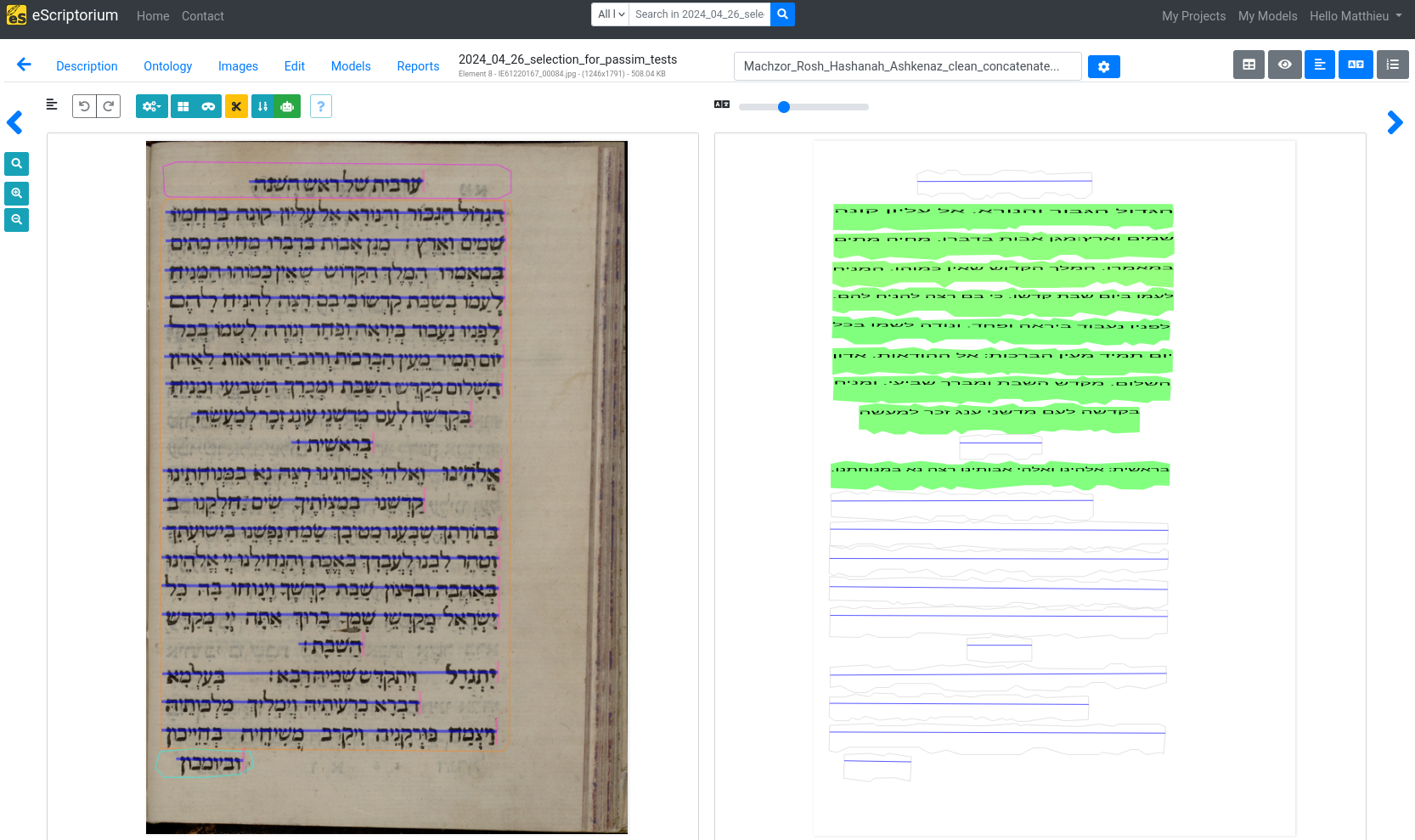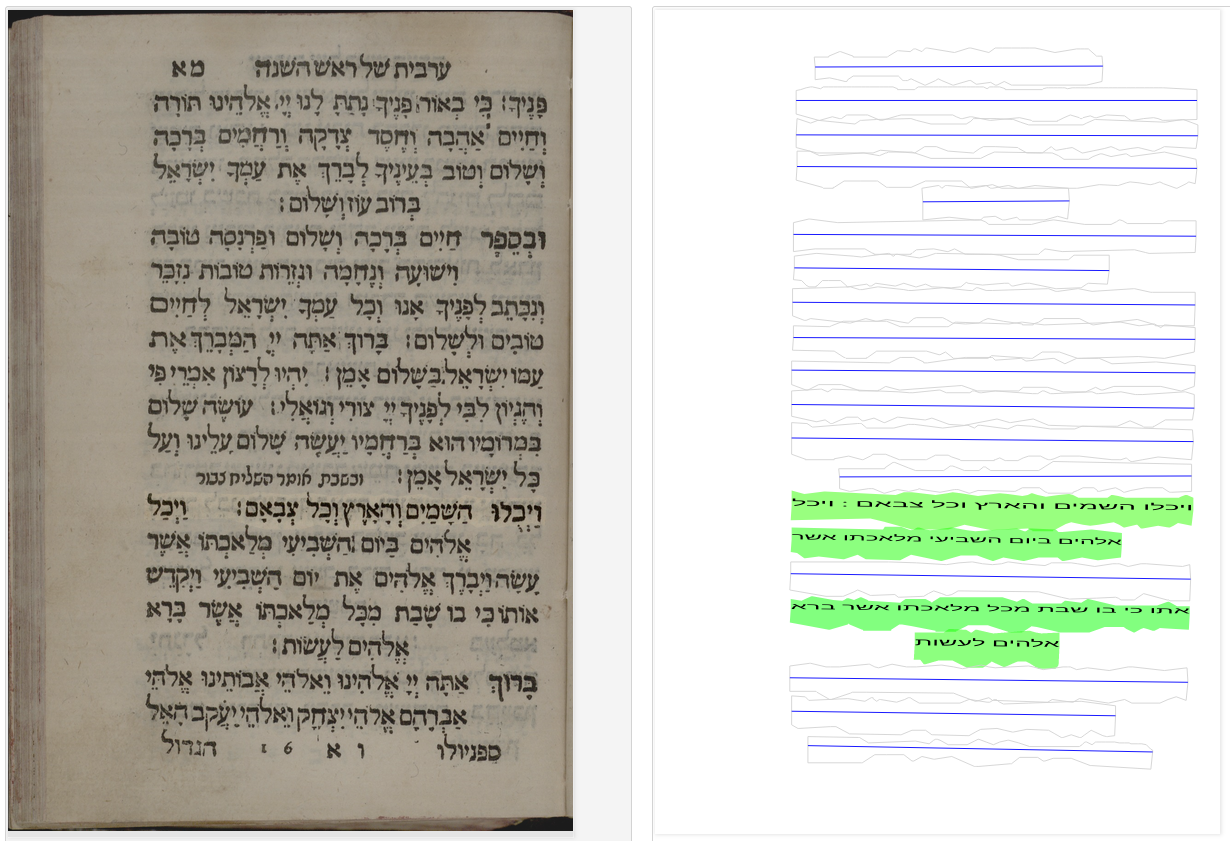TABA: a pipeline for the self-supervised creation of ground truth for training automatic transcription models of ancient Hebrew documents.
The function of the scripts in this repository is to enable the alignment on known digital texts with large numbers of digitized manuscripts or prints.
To improve a character recognition model, it is necessary to train it by providing it with transcribed lines of textual content. This method is expansive in terms of time and human resources.
By aligning digital texts with manuscript images, it is possible to reduce the cost of training a character recognition model.
The principle of this pipeline is as follows:
- textual content is extracted from manuscript images using Kraken OCR software (integrated into eScriptorium).
- Using algorithmic tools like Passim, the extracted text is compared with multiple known digital texts that constitute the ground truth (GT).
- When matches are found between OCR and GT, the two texts are aligned.
- A character recognition model can then be trained on these alignments, avoiding the need to manually transcribe text from manuscript images.
The aim of this pipeline is therefore to align large numbers of known numerical texts with large numbers of documents (manuscripts or prints).
The pipeline has been tested on batches of over 45,000 manuscript images and 150 known digital texts and corpora (such as the Hebrew Bible, Talmuds, etc.), as part of the MiDRASH project involving the Ecole Pratique des Hautes Etudes.
- Create a dedicated environment with conda:
conda create -n alignment_pipeline python=3.11- Activate the environment:
conda activate alignment_pipeline- Install passim in the environment:
pip install git+https://github.com/dasmiq/passim.git- Clone the repository:
git clone https://github.com/Freymat/from_eScriptorium_to_Passim_and_back.git- Install the required packages:
pip install -r requirements.txt-
Insert your eScriptorium token in the
credentials.pyfile. -
Configure the pipeline by modifying the
config.pyfile. More information on the configuration of the pipeline is available in the How to use the pipeline section.
- Text retrieval from eScriptorium. Altos XML files containing OCR lines from document images are retrieved from eScriptorium. The user selects the document to be processed and the regions of the page to be aligned (e.g. 'Main Central', 'Main Left').
- Prepare XML files for alignment. XML files are prepared for alignment. OCR lines are extracted from the altos XML files and concatenated into blocks of text (corresponding to page regions, e.g. 'Main Central', 'Main Left'). These strings are integrated into a dictionary, which also contains a unique identifier for each block of text. Known digital texts (GT) to be aligned are added to these dictionaries. These texts come from the Sefaria API. They have been retrieved, cleaned and prepared by the script available at this address.
- Search for alignments with Passim. Alignments are searched with Passim via a sub-process.
- Alignment recovery and integration into XML files. Valid alignments (above a certain Levenshtein distance threshold) are reintegrated into the altos XML files. The content of each OCR line is replaced by the aligned text, if valid. OCR lines without valid alignment are replaced by empty text.
- Summary of results. Several summary files are generated to evaluate alignment quality. An alignment register contains alignment information for each page. Two tsv files are created, giving for each page and each GT the number of aligned lines, and the length of successive line clusters. These files are useful for quickly identifying alignments in XML/manuscript files.
- Re-import XML files into eScriptorium. The modified altos files can then be reimported into eScriptorium via its API. A transcription layer is created for each GT aligned in eScriptorium. The user can then view the alignment result in eScriptorium.
Example of alignment in eScriptorium (left: picture of text page, right: alignment found with a levensthein ratio greater than 0.8) :
The pipeline provides the following results:
-
data/output/xmls_for_eSc/: XML files ready to be re-imported into eScriptorium. The files are organized by ground truth (GT) detected as aligned. Once imported into eScriptorium, a transcription layer is created for each GT. The layer contains the lines selected for alignment. The other lines are empty. -
data/output/alignment_register/: a dictionary listing the alignments found on each page.
{
"filename": "IE87234800_00004.xml",
"part_pk": 734751,
"part_title": "Element 17",
"levenshtein_threshold": 0.8,
"total_aligned_lines_count": 17,
"aligned_clusters_size": [
8,
5,
1,
3
],
"GT_id": "Machzor_Rosh_Hashanah_Ashkenaz_clean_concatenated.txt"
}with:
filename: alto file name, part_pk and part_title: page identifiers in eScriptorium, levenshtein_treshold: the levenshtein ratio threshold set by the user, above which the alignment is considered valid, total_aligned_lines_count: the number of lines aligned on the page, aligned_clusters_size: the number of successive lines aligned in each group of lines in the page.
- For more details on the alignment content, see the
data/processed/lines_dict_with_alg_GTfolder:
{
"text_block_id": "eSc_textblock_ab76e7e2",
"ocr_lines_in_block": 19,
"ocr_lines": [
{
"line_id": "eSc_line_4e3880cd",
"start": 0,
"end": 38,
"length": 39,
"text": "הגדול הגבור ודנורא אל עליון קונה ברחמיו",
"alg_GT": "הגדול הגבור והנורא. אל עליון קונה",
"GT_id": "Machzor_Rosh_Hashanah_Ashkenaz_clean_concatenated.txt",
"GT_start": 19915,
"GT_len": 34,
"levenshtein_ratio": 0.861
}
]
}with:
text_block_id: unique identifier of the text block in the xml alto file, ocr_lines_in_block: number of OCR lines in the block, ocr_lines: list of OCR lines with their alignment content, line_id: unique identifier of the line in the xml alto, start: start position of the line in the block, end: end position of the line in the block, length: length of the line, text: OCR line content, alg_GT: aligned ground truth content, GT_id: GT identifier, GT_start: start position of the GT in the GT file, GT_len: length of the GT line, levenshtein_ratio: levenshtein ratio between the OCR line and the detected GT text.
data/output/pipeline_timings/: a file containing the time taken for each step of the pipeline.
Current date: 2024-06-07 14:53:46
doc_pk: None
Passim n-grams: 15
Spark parameters: n_cores=38, mem=90 GB, driver_mem=40 GB
Levenshtein ratio threshold: 0.7
Number of xml files processed (OCR): 962
Number of txt files processed (Ground truth texts): 151
Step 2 (prepare OCR lines for Passim): 0:00:05.891599
Step 3 (Passim computation): 0:09:26.488877
Step 4 (xmls update with alignments from Passim): 0:01:00.126999
Step 5 (Tsv with results creation): 0:00:23.462202data/output/results_summary_tsv/: contains tsv files summarizing the results. The files give the number of aligned lines and the length of the biggest line cluster for each page and each GT.
Example of tsv file content:
 Results summary tsv file showing the number of aligned lines for each page and each GT.
Results summary tsv file showing the number of aligned lines for each page and each GT.
 Results summary tsv file showing the length of the biggest line cluster for each page and each GT.
Results summary tsv file showing the length of the biggest line cluster for each page and each GT.
 Results summary tsv file showing the number of aligned lines for the top 5 GT, for each page
Results summary tsv file showing the number of aligned lines for the top 5 GT, for each page
 Results summary tsv file showing the length of the biggest line cluster for the top 5 GT, for each page
Results summary tsv file showing the length of the biggest line cluster for the top 5 GT, for each page
 Results summary tsv file showing the number of aligned lines and the length of the biggest line cluster for each GT and each page
Results summary tsv file showing the number of aligned lines and the length of the biggest line cluster for each GT and each page
Insert your eScriptorium API access token in the credentials.py file. This token is required to import and export XML files from eScriptorium.
The configuration file config.py contains the parameters required for pipeline execution:
doc_pk(int): the id of the document containing manuscript/prints in eScriptorium.(e.g. doc_pk = 4381)region_type_pk_list(list) : the list of region types in the page, where to look for alignments. The regions are defined in eScriptorium, and are called 'MainCentral', 'MainLeft', 'MainRight', etc. Give the region type pk for each region to be processed as a list. (e.g. region_type_pk_list = [6909, 6910])transcription_level_pk(int): the transcription level in eScriptorium where the OCR lines are stored. (e.g. transcription_level_pk = 10754). This involves that a transcription layer has been created in eScriptorium before running the pipeline.
n(int): character n-gram order for alignment detection with Passim. Other passim parameters can be set. To do this, modify thecommand_passimparameter in thesrc/compute_alignments_with_passim.pyfile.n_cores(int): number of threads (Spark argument)mem(int): memory per node, in GB (Spark argument)driver_mem(int): memory for the driver, in GB (Spark argument)
levenshtein_threshold (int): for every OCR line with an alignment found by Passim, the Levenshtein ratio beetween OCR and GT is calculated. If this ratio is above the threshold, the alignment is considered valid.
Multiple tsv files are created in the data/output/results_summary_tsv/ folder. They contain the number of aligned lines and the length of the biggest line cluster for each page and each GT. The following parameters can be set (in the config.py file):
n_best_gt (int): the number of best GT to display in the tsv file where top GT are displayed.
After having set the doc_pk you want to retrieve from eScriptorium in the config.py, you can import the xml files with the following command:
python main.py --import_document_from_eScImportant: It's not possible to download and save the xml files from eScriptorium automatically in the folder data/raw/xmls_from_eSc/. The import is initiated by the --import_document_from_eS command, and the user has to download the files manually from eScriptorium and place them in the folder data/raw/xmls_from_eSc/, before running the pipeline.
It is possible to run the pipeline without connection to eScriptorium, using local XML files. The advantage is that you can use the pipeline on very large quantities of pages (xmls) without having to import them into eScriptorium.
To do this, set the variables in the config.py file as follows:
eSc_connexion = False
doc_pk = None
region_type_pk_list = [ None ]
transcription_level_pk = NoneThe xmls files must be placed in the data/raw/xmls_from_eSc/ folder.
After having put the xml files in the data/raw/xmls_from_eSc/ folder, you can run the pipeline.
The available commands are displayed with:
python main.py --helpTo run the pipeline, use the following command:
python main.py --run_all --no_importThis will compute the alignments, create the results summary tsv files, and export the XML files to eScriptorium.
If you want to skip the export to eScriptorium:
python main.py --run_all --no_import --no_exportYou can run each step of the pipeline separately with the following commands:
--import_document_from_eSc # Import document from eScriptorium
--prepare_data_for_passim # Prepare data for Passim
--compute_alignments_with_passim # Compute alignments with Passim
--create_xmls_from_passim_results # Process Passim's alignment results
--compiling_results_summary # Summarize results in tsv files
--export_xmls_to_eSc # Export results to eScriptoriumThe results are available in the data/output/ folder. The xmls_for_eSc folder contains the XML files ready to be re-imported into eScriptorium. The alignment_register folder contains a dictionary listing the alignments found on each page. The pipeline_timings folder contains a file with the time taken for each step of the pipeline. The results_summary_tsv folder contains tsv files with the number of total aligned lines and the length of the biggest line cluster for each page and each GT.
You can backup the results with the command:
python main.py --backup_resultsA .zip file with a timestamp is created in the data/results_backups folder.
The pipeline generates a large number of files. To clean the output folders, use the following command: (Beware: this command will delete all files in the output folders, make sure to backup the results before running it)
python main.py --clean_allYou can choose the data you want to delete with the following commands:
--clean_except_xmlsClean the pipeline, but keep the XML files. Useful if you want to re-run the pipeline without having to re-import the XML files from eScriptorium.
--clean_except_passimClean the pipeline, but keep the Passim results and the xmls from eScriptorium. Useful if you want to tweak the levensthein treshold.

